If you’re a first-time renter, you may not be sure exactly what’s included in your rent. Do you have to pay extra to use the dog park? Are utilities already included? If so, is there a limit to how much water or electricity you can use?
In this guide, we’ll answer your questions about what apartment rent covers or where that monthly check is going—answers that you should have before you sign a lease.
What’s typically covered by rent
Water, sewer, and trash:
Your rent often will include water, sewer, and trash services because the landlord covers this for your apartment building. However, in some cases, you may be billed for these services by either your landlord or the service providers themselves. In some circumstances, the landlord can restrict water usage—as long as it’s spelled out in your lease. If your lease doesn’t cover these subjects, you are entitled to be skeptical and should ask for clarity (preferably, on paper) before you sign it.
Maintenance and repairs:
If your toilet won’t flush or your air conditioning doesn’t work, your landlord is supposed to fix them (unless you damaged them). In other words, you shouldn’t be expected to schedule an appointment with a repair company and pay the repair bill. Also, routine maintenance tasks are usually covered by the landlord, such as regularly spraying for bugs, testing your smoke detectors, and testing your fire extinguisher.
Parking:
Most of the time, parking is part of your rent. However, the convenience of using a covered parking space, having a reserved spot, or parking in a garage usually involves an extra monthly fee. If you’re unsure, check the lease—especially if you’re renting in a city or neighborhood where parking spots are extra scarce.
Amenities:
The ability to use the apartment complex’s dog park, swimming pool, gym, and other facilities is usually included in your rent. Also, you may be given free access to an on-site laundry room. However, you’ll have to pay to wash and dry your clothes, and you’ll have to bring your own laundry supplies.
What’s typically not covered by rent
Electricity:
Normally, the cost of electricity won’t be included in your monthly rent; instead, it’ll be billed separately by the utility provider. Some landlords do include electricity in your rent, though. If electricity is included, there might be a surcharge if you use an excessive amount of power. Inquire about this before you sign a lease.
Natural gas:
If your apartment is equipped with natural gas for heating or cooking, it likely won’t be included in the rent, so you’ll have to cover it yourself.
Internet and cable TV:
In most cases, your rent won’t cover internet and cable TV services. Rather, you’ll need to pay for these services on your own.
Furnishings:
Unless you rent a furnished apartment, your new place won’t come with a sofa, a bed, chairs, and other furniture. With an unfurnished apartment, you’ll need to provide all of your own furnishings, or find affordable furniture for rent in your city.
Insurance:
The landlord will carry property insurance for the structure where your apartment is. However, you must buy renter’s insurance to protect your personal belongings, such as furniture, electronic devices, and clothing that you own. In fact, some states and landlords require you to buy renter’s insurance!
Damage:
Let’s say you, a relative or a guest accidentally knocked a huge hole in a living room wall. Or perhaps your dog clawed your kitchen floor and left a lot of deep scratch marks. In these instances, you’ll typically have to come up with cash to repair the damage, because it’s ultimately your fault.
If you fail to fix the damage before you move out, the landlord might keep all or part of your security deposit to cover the repair costs. If your security deposit does not cover the repair costs, the landlord or property management may send you to collections which can affect your credit. Also, if the damage is too severe or happens too frequently, the landlord may have grounds for eviction.
If you’re worried about eviction because you are cash-strapped, make sure you read these tips on how to bounce back when you can’t afford rent.
Maintenance:
Earlier, we told you that the landlord covers some routine maintenance tasks. Others, however, usually are not covered. For example, if the battery in your living room’s smoke detector dies or a light bulb in a bathroom fixture burns out and needs to be replaced, it’s usually your responsibility to take care of that. If you don’t the cost of these simple repairs may come out of your deposit.
Cleaning:
Unless you live in a luxury apartment, house-cleaning services generally aren’t covered as part of the rent. However, upkeep and clean-up in the common spaces—like stairways and sidewalks—are supposed to be the landlord’s responsibility. That being said, make sure that you clean up after your pet in shared space to avoid getting fined by the city or your apartment complex.
Storage:
More and more apartments are offering on-site storage—for an additional cost. In some cases, though, you may be able to score more storage by asking your leasing agent or landlord for apartments with walk-in closets, built-in shelving, or even attics! Need more storage than that? In that case, you may be better off renting a house rather than an apartment.
Now that you know, start apartment searching! With ApartmentSearch, you can browse hundreds of listings in cities across the country. Find an apartment with rent that you can manage, then talk to the landlord about what’s included.
